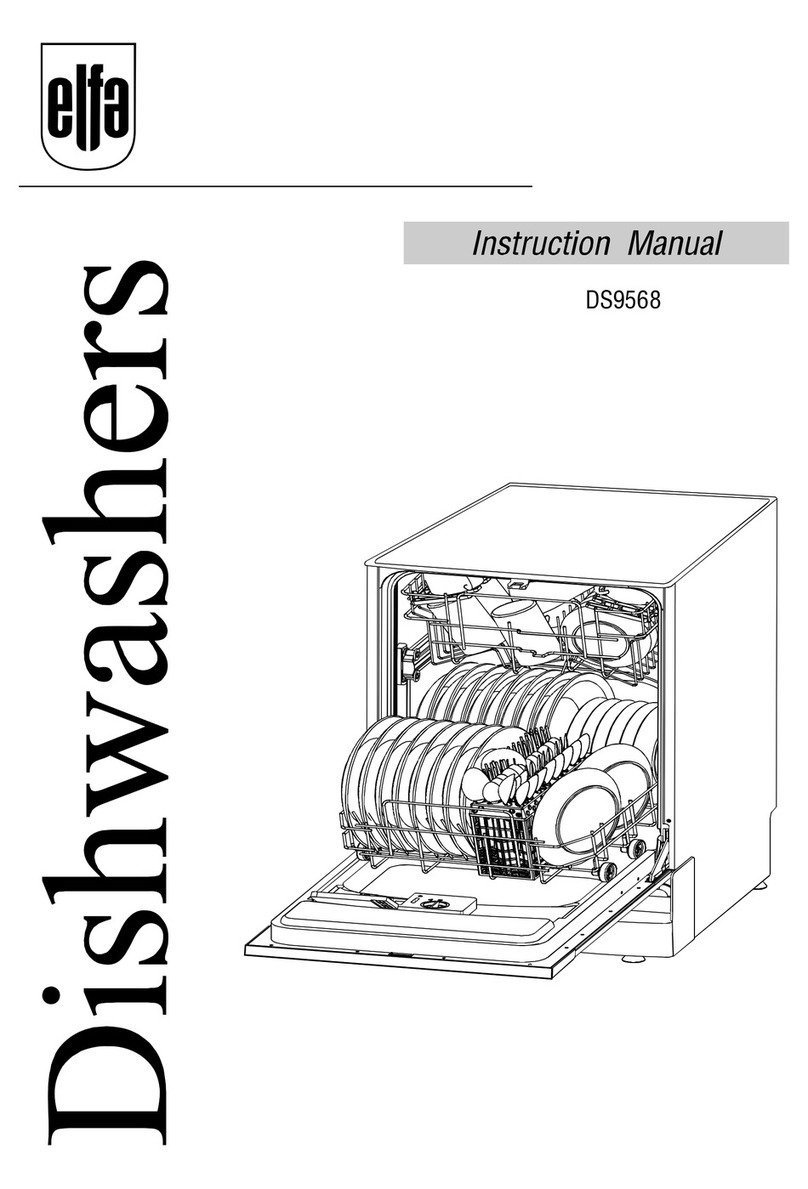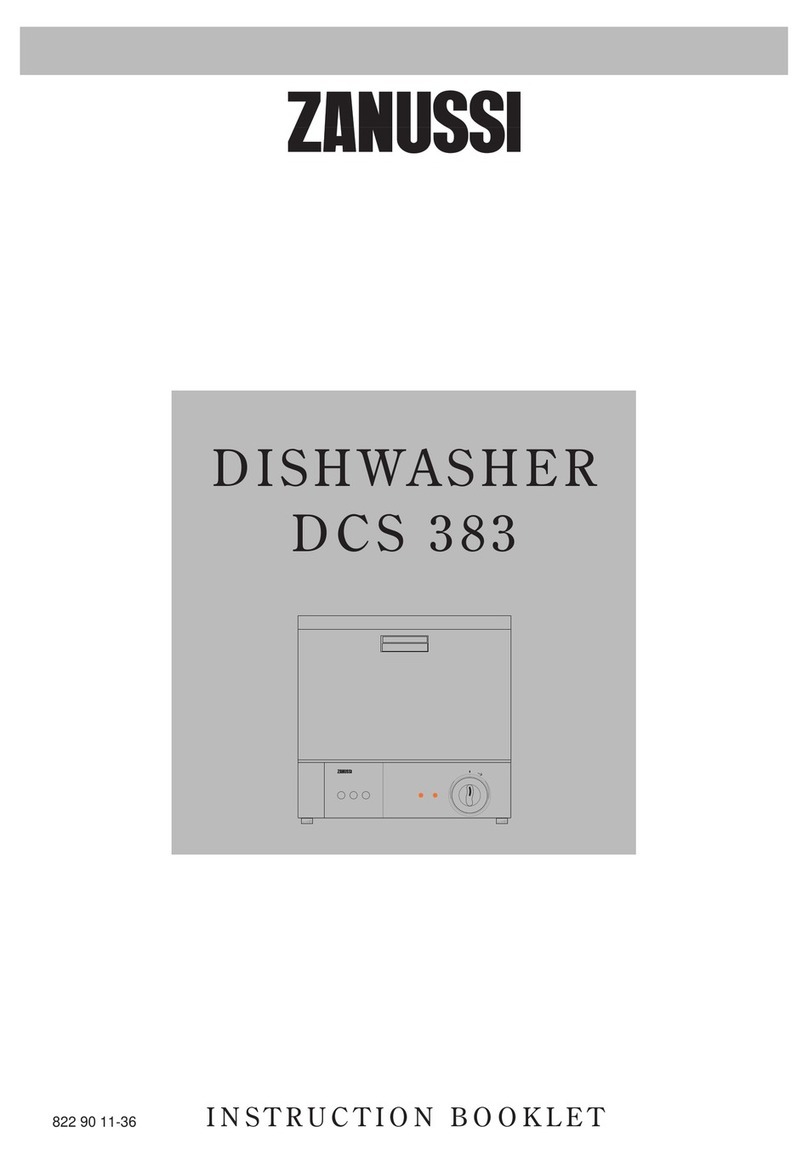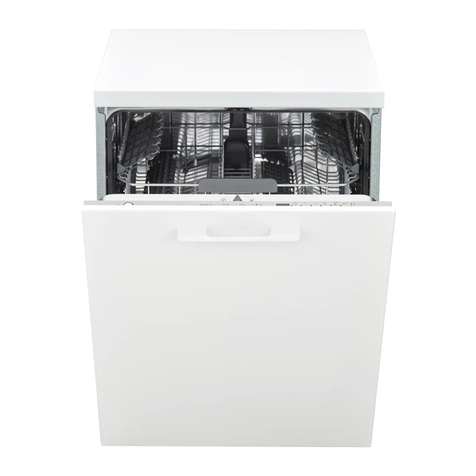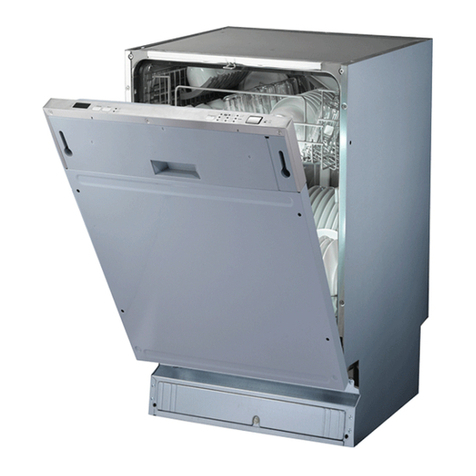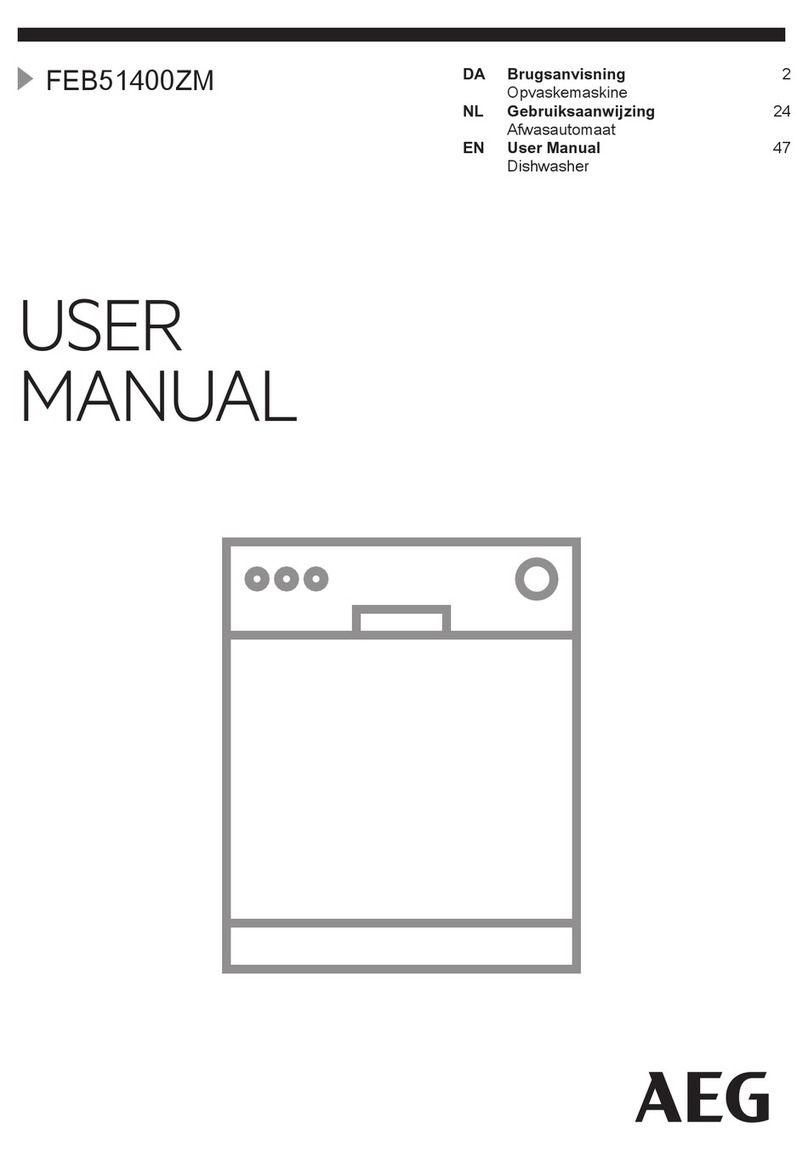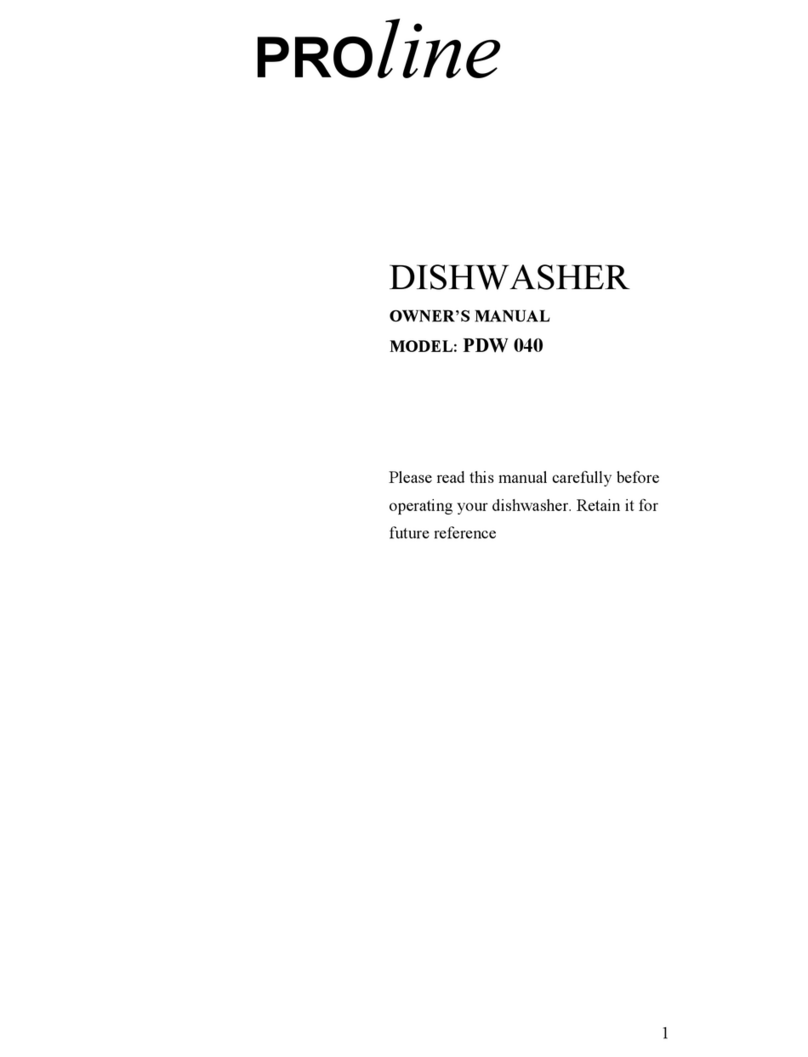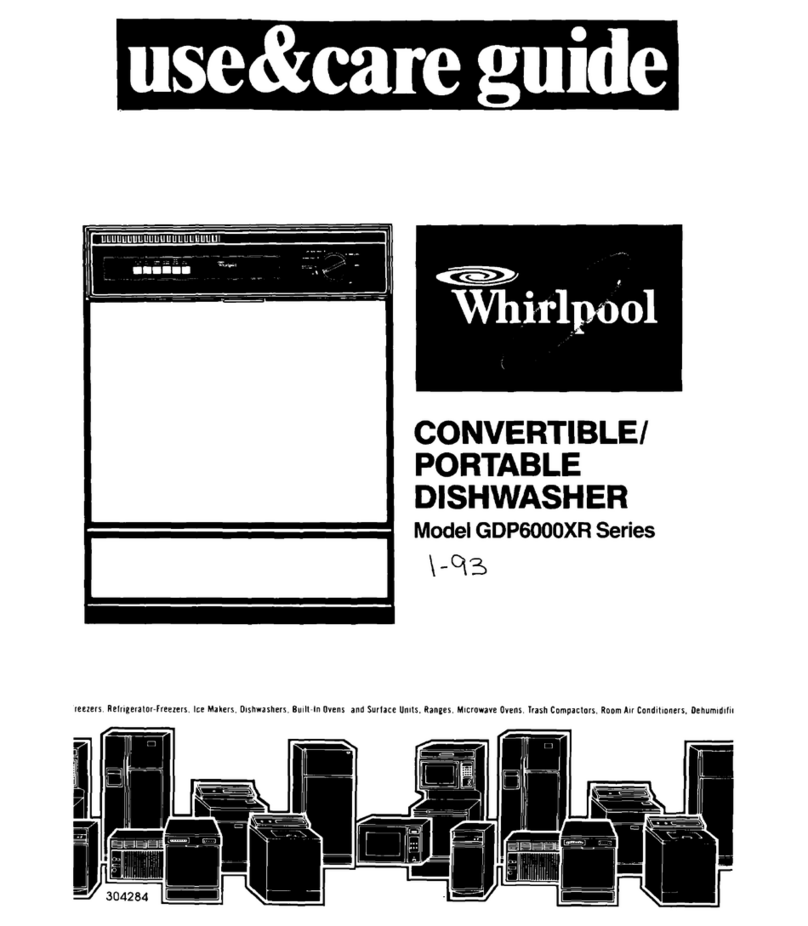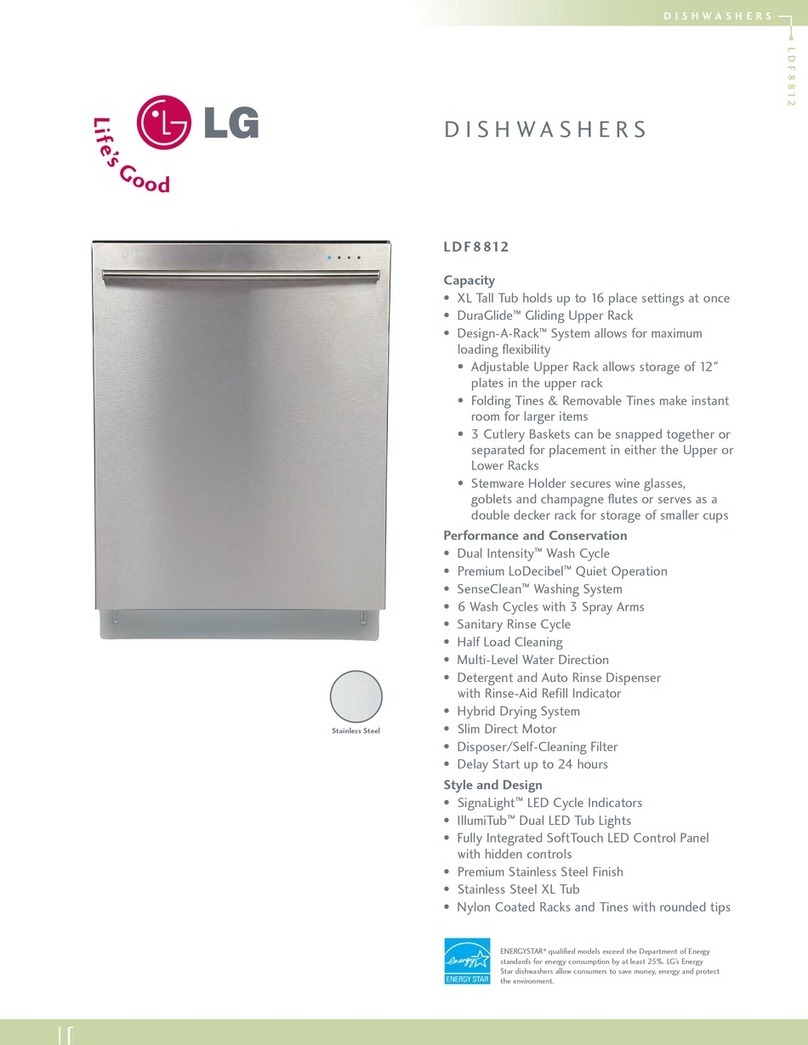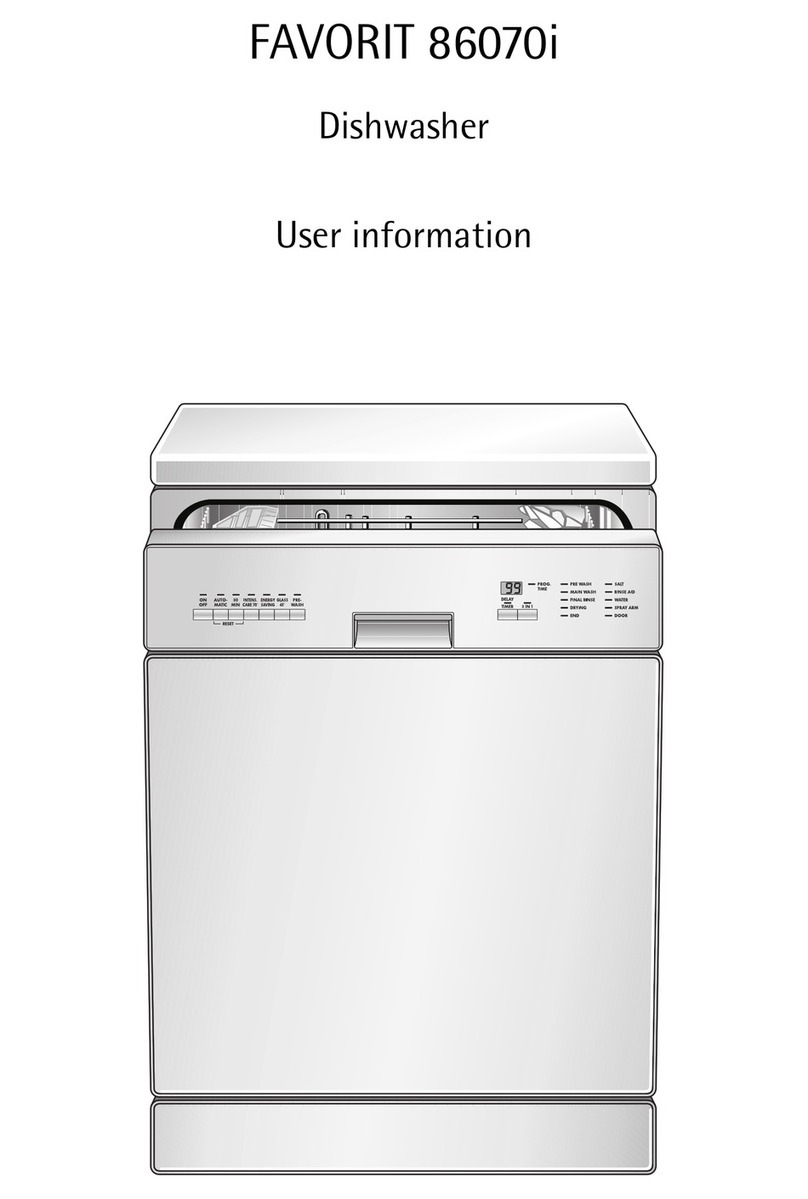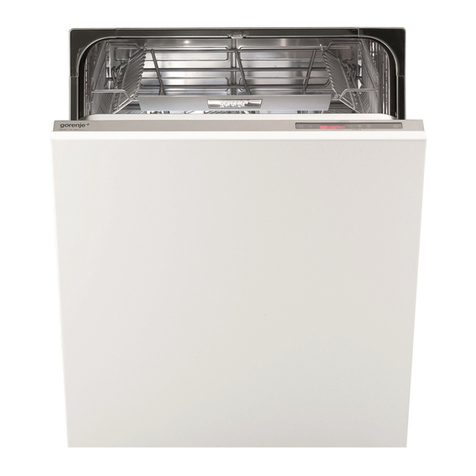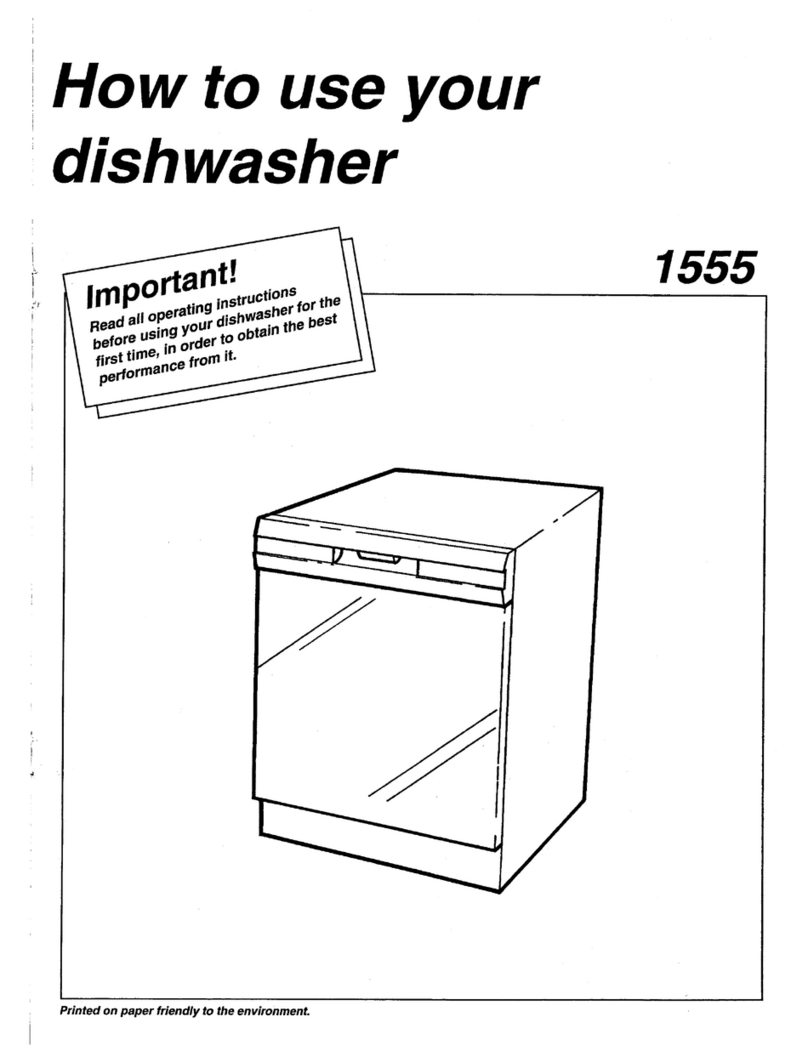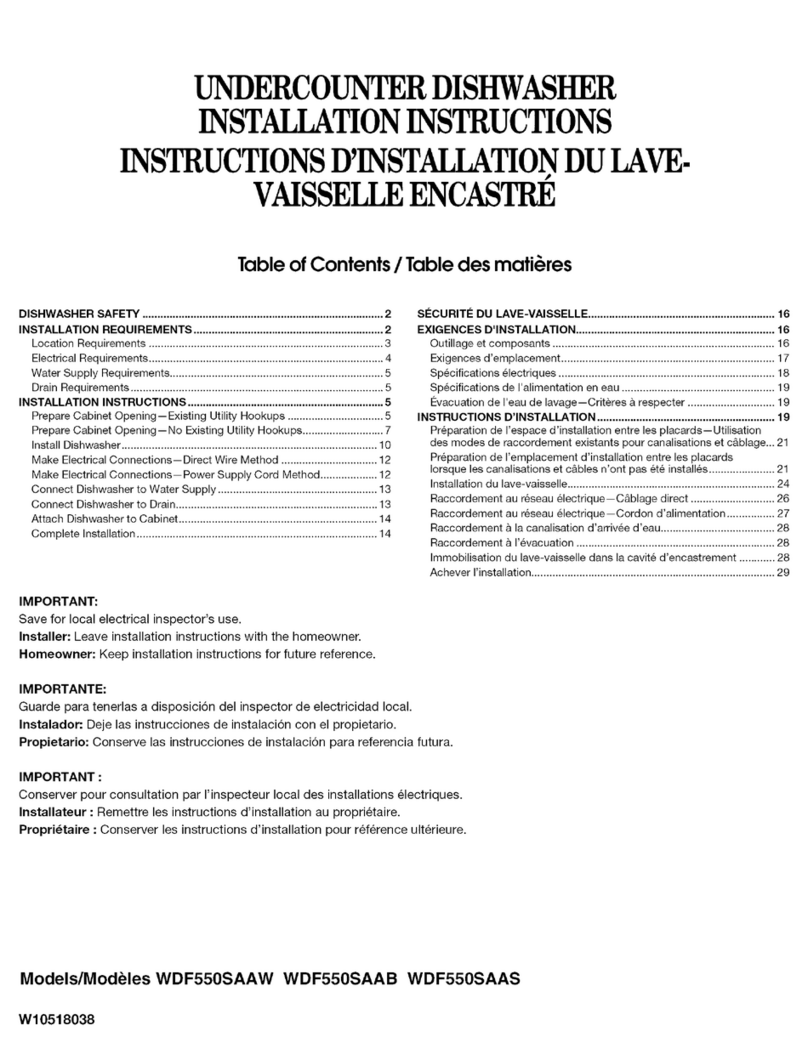Elfa DS1480SS User manual

DS1480SS
14 place settings
half-load function

With each wash cycle.
Compartment
For programmes with pre-wash only.
(Follow the user instructions!)
Electric indicator on control panel (if provided).
Check the rinse aid level
Load the baskets
Switch off the appliance
Turn off the water tap,
unload the baskets
Fill the detergent dispenser
Warning: wait a few minutes (about 15 minutes) before unloading the dishwasher to avoid handling
the dishes and utensils while they are still hot and more susceptible to break.
They will also dry better.Unload the appliance, starting from the lower basket.
Scrape off any large amount of leftover food. Soften remnants of burnt food in pans,
then load the baskets. Refer to the dishwasher loading instructions.
When the working cycle has finished, the buzzerof the
dishwasher will sound 8 times, then stop.
Turn off the appliance using the On/Off Button.
Switch on the appliance Press the On/Off button to switch on the appliance,Open the door.
For detailed operating method read the corresponding content on the instruction manual.
Select a programme
Turn on the water tap and press the Start/Pause Button. The machine will start working
after about 10 seconds.
Running the dishwasher
Changing the programme
Add forgottendishes in the
dishwasher.
If the appliance is switched
off during a wash cycle.
Openthe door carefully.
Hotsteammay escape
when the door is opened!
If the appliance is switched off during a wash cycle, when switched
on again, please re-select the washing cycle and operate the dishwasher
according to the original Power-on state ).
Close the door,press the Programme Button to select a desired programme.
( See the section entitled Operating instruction )“”
1.PresstheStart/PauseButtontostopthewashing.
2.Open the door a little .
3.After the spray arms stop working, you can open the door completely.
4.Add forgotten dishes.
5.Close the door
6.Press the Start/Pause Button, the dishwasher will run after 10 seconds.
1. A running cycle can only be modified if it has been running for a short time. Otherwise the detergent
may have already been released and the water already drained. If this is the case, the detergent
dispenser must be refilled.
2. Press the Start/Pause button then press the program button for more than 3 seconds tocancel the
running programme.
3. Select a new programme.
4. Restart the dishwasher.

To review the section ontroubleshooting Tips
will help you to solve some common problems
by yourself .
Dear Customer,
Please carefully readthismanualbefore usingthe
dishwasher,it will help you to use and maintain the
dishwasher properly.
Pass it on to anysubsequent owner ofthe appliance.
Thismanual contains sections on safety Instructions,
Operating Instructions, InstallationInstructions and
Troubleshooting Tips, etc.
The manufacturer, following a policy of constant
development andupdating of the product, may
make modifications without giving prior notice.
Keep it as arefer in the later days.
If you can not solvethe problems by yourself ,
please ask for the help of professional technicians.
Thisappliance is intended tobe usedin household
andsimilarapplications suchas:
-staff kitchen areas in shops, offices and other
working environments;
-farm houses;
-byclients inhotels,motels and otherresidential
type environments;
-bed and breakfast type environments.
Dishwasher Features.................................... ...2
AttentionbeforeorafterloadingtheDishwasher
Baskets..........................................................6
Filtering System.............................................10
Caring forthe Dishwasher..................... .........11.
A Fill the RinseAid Dispenser............. .. ..3、..... ...
B Function of Detergent .........................4、........
..............7
The Method Loading Normal Dishware
Wash CycleTable...........................................8
Turning on theAppliance................................8
Change the Programme.............. ................9....
At theEne of the Wash Cycle...........................9
PositioningtheAppliance................... ..........12..
Water Connection.................................. .......13.
AboutPowerConnection........................ .......12.
Startof dishwasher................................ ......14..
Before calling for service........................... .....15.
Errorcodes.................................... ..............16.
Technical information.............................. .....17..
Control Panel...................................................2

This appliance must be grounded. In the event of a
malfunction or breakdown, grounding will reduce
the risk of anelectric shock by providing a path of
least resistance of electric current. This appliance
is equipped with a cord having an equipment-
grounding conductor and a grounding plug.
The plug must be plugged into an appropriate outlet
that is installed and grounded in accordance with
all local codes and ordinances.
Keep children away from detergent and rinse aid, keep
child away from the open door of the dishwasher,
there could still be some detergent left inside.
ren
Donotabuse,siton,orstandonthedoorordish
rack of the dishwasher.
Do not touch the heating element during or
immediately after use.
(This instruction is only applicable to machines
with a visual heating element.)
Do not wash plastic items unless they are marked
dishwasher safe or the equivalent. For plastic items
not so marked, check the manufacturer's
recommendations.
Use only detergent and rinse additives
designed for an automatic dishwasher.
Never use soap, laundry detergent, or hand
washing detergent in your dishwasher. Keep
these products out of the reach of children.
During installation, the power supply must not
be excessively or dangerously bent or flattened.
Do not tamper with controls.
Do not place any heavy objects the
door when it is open. The appliance could tip
forward.
on or stand on
When loading items to be washed:
1) Locate sharp items so that theyare not likely
to damage the door seal;
2 Warning: Knives and other utensils with
sharp points must be loadedinthe basket
with their points down orplacedin a
horizontal position.
)
When using your dishwasher, you should
prevent plastic items from coming into contact
with the heating element.(This instruction is only
applicable to machines witha visual heating
element.)
Ifthesupplycord isdamaged, it mustbe replaced
bythemanufactureroritsserviceagentora
similarly qualified person in order to avoid a
hazard.
Please dispose of packing materials properly.
Use the dishwasher only for its intended function.
Remove the door to the washing compartment when
removing an old dishwasher from service or discarding it.
Dishwasher detergents are strongly alkaline, they
can be extremely dangerous if swallowed.Avoid
contact with skin and eyes and keep children away
from the dishwasher when the door is open.
Check that the detergent comparment is empty
after completion of the wash cycle.
The applianceis to be connected to the water
mains using new hose sets and that old hose-sets
should not be reused.
The maximum number of place settings to be
washed is14.
The maximum permissible inlet water pressure is
1Mpa.
The minimum permissible inlet water pressure is
0.04Mpa.
Children should be supervised to ensure that they do
not play with the appliance.
This appliance is not intended for use by persons
(including children with reduced physical, sensory or
mental capabilities, or lack of experience and
knowledge ,unless they have been given supervision
or instruction concerning use of the appliance by a
person responsible for their safety.
)
When using your dishwasher, follow the precautions listed below:
The door should not be left open,
since this could increase the risk of tripping.
Improper connection of the equipment-grounding
conductor can result in the risk of an electric shock.
Check with a qualified electrician or service
representative if you are in doubt whether the
appliance is properly grounded. Do not modify the
plug provided with the appliance; If it does not fit
the outlet. Have a proper outlet installed by a
qualified electrician.
Do not operate your dishwasher unless all
enclosure panels are properly in place. Open
the door very carefully if the dishwasher is
operating, there is a risk of water squirting out.

8
Back View
1
2
3
4
5
6
7
Front view
Dispenser
CupShelf
Sprayarms
Filterassembly
Inletpipeconnector
Drain pipe
Lower Basket
Inner pipe
UpperBasket
1
beforeusing it for the firsttime.
To get the best performance fromyourdishwasher,read all operating instructions
4
5
6
7
8
9
3
2
9
8. Start /Pause button: Tostart the selected
washing program or pause the washing program
when the machine is working.
1. On/Off Button: to switch On/Off theappliance. 7. Half load functions Button: To select Half load
functions.(With this Half load function you can
only use it when you haveonly about or less than
6 place setting dish wave, and you will see less
water and energy consumption , can onlybe used with
Intensive, Heavy, Normal,Glass and 1 Hour .)
3. Power indicator :To show when the power on.
2.Program Button :To Press the button toselect
appropriate Program.
4. Program indicators:To show which program
you havechose.
5. Half load indicators:To show Half load functions
starting up or not.
Rinse aid warninglights:To show
whenthe dispenser need to be refilled
Water faucet light:to show when the water
faucet is forget turn on.
6.

Before using your dishwasher for the first time:
A. Filltherinse aiddispenser
B. Fill in detergent
Therinse aid isreleased duringthe finalrinse to prevent water from forming dropletson your dishes, which can
leave spots and streaks. It also improvesdryingby allowing water to rolloff thedishes. Yourdishwasheris
designed to use liquidrinseaids.The rinseaid dispenser islocated insidethe door nextto thedetergent dispenser.
To fill the dispenser,open the capand pour the rinse aidinto the dispenser untilthe level indicator turns completely
black.Thevolume ofthe rinseaidcontaineris about 110ml.
RinseAid Dispenser
Function of RinseAid
Rinse aid is automatically added during the last rinse, ensuringthorough rinsing, and spot and streakfree drying.
Attention!
Onlyuse branded rinse aid for dishwasher. Never fill the rinseaid dispenserwith any other substances
(e.g. Dishwasher cleaning agent, liquid detergent). This would damage the appliance.
As the rinseaid diminishes, the size of the black dot
on the rinse aid levelindicator changes, as illustrated below.
Full
3/4full
1/2full
1/4full-Shouldrefilltoeliminatespotting
Empty
If there is no rinse-aid warning light in the control panel, you can judge the amount of rinse-aid by the color of the
optical level
indicator "C" located next to the cap. When the rinse-aid container is full, the whole indicator will be dark .As the
rinse-aid
diminishes, thesize of the dark dot decreases.You should never let the rinse aid get below 1/ 4 full.
When to Refill the RinseAid Dispenser
RINSEAID DISPENSER
To open the dispenser, turn the cap to the "open" (left) arrow and lift it out.
Pour therinse aid into the dispenser, being careful not to overfill.
Replace the cap by inserting it alignedwith "open" arrow and turning it tothe closed (right) arrow.
Be careful not tooverfill the dispenser,because this could cause over sudsing. Wipe away any spills
witha damp cloth. Don't forget to replace the cap before you close dishwasherdoor.
Attention!
Clean up any rinse aid split during filling with an absorbent cloth toavoid excessfoaming
during the nextwash.
1
2
3

Adjusting RinseAid Dispenser
The rinse aid dispenserhas six or four settings.Always start with the dispenser
set on "4". If spots and poor drying are a problem, increase the amount of rinse
aiddispensedby removing thedispenserlidandrotatingthedialto"5".Ifthe
dishes still are not drying properly or are show spots, adjust the dial to the next
higher lever until your dishes are spot-free. The recommended setting is "4".
(Factory value is "4".)
Increase the dose if there are drops of water or lime spots on the dishes after washing.
Reduce it if there are sticky whitish stains on your dishes or abluish film on glassware or
knifeblades.
during thenextwash.
Don't forget to replacethe cap before you closedishwasher door.
Cleanup any rinse aid spilled while during fillingwith an absorbent cloth to avoid excessive foaming
Detergents with its chemical ingredients are necessary to remove dirt, crush dirt and transport it out of the dishwasher.
Most of the commercial quality detergentsare suitable forthis purpose.
Detergents
There are 3 sorts of detergents
1.With phosphate and with chlorine
2.With phosphate and without chlorine
3.Without phosphate and without chlorine
Based on their chemicalcomposition, detergentscan be split in two basic types:
Detergent tablets of different brands dissolve at different speeds. For this reason some
detergent tablets cannot dissolve anddevelop their full cleaning power during short
programs. Therefore please use long programs when using detergent tablets, to
ensurethe completeremovalof detergent residuals.
The dispenser mustbe refilled before the start of each wash cycle followingthe instructions
provided in the wash cycle table .Your dishwasheruses less detergent andrinse aid than
Conventional dishwasher. Generally, only one tablespoon of detergent is needed for
a normal wash load.Moreheavily soiled items need more detergent.Alwaysaddthe
detergent just before starting thedishwasher, otherwise it could get damp and will not
dissolve properly.
Concentrated Detergent
DetergentTablets
DetergentDispenser
conventional, alkaline detergents with caustic components
lowalkaline concentrated detergents with natural enzymes
Normally new pulveriseddetergent is without phosphate.Thus the water softener function of
phosphate is not given. In this case we recommend tofill salt in the salt container even when
the hardness ofwater is only6 dH. Ifdetergentswithout phosphate are used inthe case ofhard water
often white spots appearondishes and glasses. In this case please add more detergent to reach
better results. Detergents without chlorine doonlybleacha little. Strong and coloured spots will not
be removedcompletely.In thiscase please choose aprogramwitha higher temperature.
°

Amount ofDetergenttoUse
ProperUseofDetergent
Use only detergent specifically made for the use in dishwashers. Keep your detergent fresh and dry.
Don't put powdereddetergent into the dispenser until you're ready to wash dishes.
Dishwasher detergent is corrosive! Takecare tokeep itout of reach of children.
Always add the detergentjustbefore starting each wash cycle.
Only use branded detergent aid for dishwasher.
If thelid is closed: press release button. The lid will spring open.
Detergent tablet
Detergent powder
Fill the detergent dispenser with detergent.
Themarkingindicatesthedosinglevels , as
illustratedontheright:
The place of main wash cycle detergent placed.
The place of pre-wash cycle detergent placed.
Please observe the manufacturers dosing andstorage
Recommendations as stated on the detergent packaging.
Close the lidandpress until itlocks inplace.
Ifthedishesare heavily soiled,placean additional
detergent dose in the pre-wash detergent chamber. This detergent will take effect during the pre-wash phase.
A
B
Fill in Detergent
You find information about the amount of detergent for the single programme on the last page.
Pleaseaware,that according tothe level soiling andthespecific hardness of water differences are possible.
Pleaseobserve the manufacturer's recommendations on the detergent packaging.

Cutlery with wooden,horn china or
mother-of-pearl handles
Plastic items that are not heat resistant
Older cutlery with glued parts that are not
temperatureresistant
Bonded cutlery items or dishes
Pewter or cooper items
Crystal glass
Steel items subject to rusting
Wooden platters
Items madefromsyntheticfibres
Some types of glasses can become
dull aftera large number of washes
Silver and aluminum parts have a
tendency to discolourduring washing
Glazed patterns may fade if machine
washed frequently
Are not suitable Are oflimited suitability
Dishes and itemsof cutlery mustnot lie insideoneanother, or cover eachother.
To avoid damage to glasses,they must not touch.
Load large itemswhich are most difficult to clean into the lower basket.
The upper basket isdesigned to holdmoredelicate and lighter dishware such as glasses, coffee
andteacups
Long bladed knives stored in an upright position are a potential hazard!
Long and/or sharp items of cutlery such as carving knives must be positioned
horizontally in the upper basket.
Please do not overload your dishwasher. This is important forgood results and for
reasonable consumption of energy.
Load hollow items such as cups, glasses, pans etc. With the opening facing downwardsso that
water cannot collect in the container or a deep base.
Consider buying utensils which are identifiedasdishwasher-proof.
Usea mild detergent thatis describedas 'kind to dishes'.If necessary, seekfurther
information fromthedetergent manufacturers.
Forparticular items,select aprogramwithaslowatemperature aspossible.
To prevent damage, do not take glassandcutlery out of the dishwasher immediately
after the programme has ended.
(For best performance of the dishwasher, follow these loading guidelines.
Features and appearance ofbaskets and cutlerybasketsmay vary from yourmodel.)
Scrape off any large amounts of leftover food.Soften remnants ofburnt food in pans.
It is not necessary to rinse the dishes under running water.
Place objects in the dishwasher in following way:
1.Items such as cups, glasses, pots/pans, etc. are faced downwards.
2.Curved items, or ones with recesses, should be loaded aslant so that water can run off.
3.All utensils are stacked securely and can not tipover.
4.All utensils are placed in the way that the spray arms can rotate freely during washing.
Very small items should not be washed in the dishwasher as they could easily fall out of the basket.
To prevent water dripping from the upper basket into the lower basket, we recommend that you
empty the lower basket first and then the upper basket.

The upper basket is designed to holdmore delicate
and lighter dishware such as glasses, coffee and
teacups and saucers, as wellas plates, small bowls
andshallowpans (as long asthey arenot toodirty).
Positionthe dishes andcookwareso thatthey will
notgetmoved bythespray ofwater.
We suggest that you place large items and the most
difficult tocleanitemsaretobe placedintothelower
basket: such aspots, pans, lids, serving dishes and
bowls, as shown in the figure below. It is preferable to
place serving dishes and lids on the side of the racks
in order to avoid blocking the rotation of the top spray
arm.
Pots,servingbowls,etc,mustalwaysbeplacedtopdown.
Deep pots should be slanted to allow water to flow out.
Please be reminded that:
The Bottom Basket features folding spikes so that larger or more pots and pans can be loaded.
Folding Spikes of Lower Basket
For better stacking of pots and pans,
the spikescan be folded down as
show in the picture right.
Folding back the cup shelives
For better stacking of pots and pans,
the spikes can be folded down as
show in the picture right.
Cutleryshouldbe placed inthecutlery rackseparately
from each other in the appropriate positions, and do
make sure the utensils do not nest together, this may
causebadperformance.
Adjusting the Upper Basket
Theheight of the upper basket can be adjusted inorder to
create morespace for largeutensilsbothforthe upper
/lower basket. The height of the upper basket can be
adjusted by placing the wheels on different height of the
rails. Long items, serving cutlery, salad servers and knives
shouldbe placed ontheshelf sothattheydo not obstruct
therotationofthesprayarms..

Means: need to fill rinse into the Rinse-Aid Dispenser.
()
* : This program is the test cycle. The information for comparability test
in accordance with , as follows:
AS/NZS 2007.1
AS/NZS 2007.1
Capacity: 14 setting
Position Upper basket: upper wheels on rails
Rinse aid setting: 6
Open the door slightly 50mm to assistin drying of the dishes after every wash
Starting acycle wash
1 Draw out the lower and upper basket, load the dishesand push them back.
It is commended to load the lower basketfirst, then the upper one (see the section entitled
Loading the Dishwasher ).
2 Pour in the detergent (see the section entitled Detergent and RinseAid ).
3 Insert the plug into the socket. The power supply is 220-240 VAC /50 HZ, the specification
of the socket is 10A 250VAC. Make sure that the water supply is turned on to full pressure.
4 Close the door, press the ON/OFF Button, and the ON/OFF light will turn on.
5Presstheprogrambutton
If aprogram isselected, theresponse light will light.Then press the Start/Pause button, the
dishwasher begins to start.
“”
“”
, the wash program will be changed as follows direction:
Intensive->Heavy-> ->Glass->1 Hour ;Normal ->Soak
Normal
Intensive
Heavy
(OrAll )in1
5/27.5g
(OrAll )in1
5/27.5g
(OrAll )in1
5/27.5g
Pre-wash(50 )
Wash (65 )
Rinse
Rinse
Rinse(65 )
Drying
℃
℃
℃
Pre-wash(45 )
Wash (55 )
Rinse
Rinse (60 )
Drying
℃
℃
℃
Per-wash
Wash (50 )
Rinse
Rinse(50 )
Drying
℃
℃
165
160
135
1.15
0.90
1.4
18
14.5
13.9
1Hour
Pre-wash(50 )
wash(60 )
Rinse (55 )
Drying
℃
℃
℃
60 10
0.9
5/27.5g
(*AS/NZS 2007.1)
For heavily soiled loads,
such as pots,plates, glasses
and lightly soiled pans.
Glass
20g
Pre-wash
wash(40 )
Rinse
Rinse(60 )
Drying
℃
℃
115
0.8 14.5
For heaviestsoiled crockery,
and normally soiled pots
pans dishes etc with dried
onsoiling.
、
、
For lightly soiled crockery
and glass
Standard dailycycle for
normally soiled loads, such
as pots plates glasses.、、
For lightly soiled loads that
do not need excellentdrying
efficiency.
Torinsedishes that you plan
to wash later that day.
Soak
Pre-wash
80.01
3.8

When the working cycle has finished, the buzzer of the dishwasher will sound for 8seconds, then stop.Turn off
the appliance using the ON/OFF button, shut off the water supply and open the door of the dishwasher.
Wait for a few minutes before unloading the dishwasher to avoid handling the dishes and utensils while they
are still hotandmore susceptible to breakage. They will also dry better.
Switch Off the Dishwasher
The program light is on but is notblinking, only in this case the programme has ended.
1.Switchoff thedishwasher by pressing the ON/OFF button.
2.Turnoff the water tap!
Open the door carefully.
Hotdishes are sensitivetoknocks. The dishes shouldtherefore beallowedto cooldown around15minutes
before removing from the appliance.
Open the dishwasher's door,leave it ajarand waita few minutes beforeremoving the dishes. In thisway they
will be cooler and the drying will be improved.
Unloadingthedishwasher
It is normal that the dishwasher is wet inside.
Empty the lowerbasketfirst and thentheupper one.Thiswill avoidwater dripping fromtheupper Basketonto
thedishesinthelowerone.
If you open the door , the machine will pause. The program light will
stop blinking and the buzzer will mooing every minute unless you close the door.After
you close the door ,the machine will keep on working after 10 seconds.
duringawashcycle
Premise:
Acycle that is underway canonly be modified if it has only been running for a short time. Otherwise, the
detergentmayhavealreadybeenreleased, andthe appliancemayhave already drained the wash water.
If thisis the case, the detergent dispenser must be refilled (see the section entitled " Loading the
Detergent " ).
Press the Start/Pause button , the machine will be in standby state, press the program button more than
3s then you can change the program tothedesired cycle setting (see thesection entitled "Starting awash
cycle. . .").
1
2
Aforgotten dish can be added any time before the detergent cup opens.
Add forgotten dishes.
Close the door
After the spray arms stop working, you can open the door
completely.
2
3
Open the door a little .
14
5
6
Press the Start/Pause Button to stop the washing.
Press the , the dishwasher will run
after 10 seconds.
Start/Pause Button
When youpressthe Start/Pause button to pause during washing,the will
stop blinking and the dishwasher will mooing every minute unlessyou press the
Start/Pause button to start.
running indicator
Washthearms in soapy andwarm waterandusea softbrushto
clean the jets. Replace them after rinsing them thoroughly.
When following this procedure from step1 to step 3, the filter system will be removed;
when following it from Step 3 to Step 1, the filter system will be installed.
It is dangerous to open the door when washing,becausethe hot water may scald you.

The filter prevents larger remnants of food or other objects from getting inside the pum.
Theresidues may blockthefilter, inthis casethey must be removed.
The filter system consists of a coarse filter,a flat (Main filter)
Anda microfilter(Fine filter).
Food and soil particles trapped inthisfilterarepulverizedby a
special jet on the lower spray arm and washed down to drain.
Larger items, such as pieces of bonesor glass, that could block
the drain aretrappedin the coarse filter.To remove theitems
caught by the filter, gently squeeze the tap onthetop of this
filterandliftout.
Thisfilter holds soil and food residuesin the sump areaand
prevents itfrom being redeposit on the dishes during wash cycle.
Main filter
1
Coarse filter
2
Fine filter
3
2
3
1
Filterassembly
Thefilter efficiently
For best performance and results, the filter must be cleaned regularly. this reason, it is a goodidea to
remove the larger food particlestrappedin the filter after each wash cycleby rinsing the semicircular filter and
cup under running water. To remove the filter device, pull the cup handle in the upwarddirection.
removes food particles from the wash water, allowing it to be recycledduring the cycle.
For
The dishwasher must never be used without the filters.
Improper replacementof the filter may reduce the performance level ofthe appliance
and damage dishesand utensils.
Step 1 Turn the filter in anti-clockwise direction,:
Step 2 lift the filter assy up:
When following this procedure from step1 to step 2, the filter system will be removed;
when following it from Step 2 to Step 1, the filter system will be installed.
1
2

The control panel can be cleaned by using a lightly dampened cloth.
After cleaning, make sure to dry it thoroughly.
For the exterior, use agood appliance polish wax.
Never usesharp objects, scouring pads or harsh cleaners onany part ofthe dishwasher.
ProtectAgainst Freezing
1.Cut off the electrical power to the dishwasher.
2.Turn off the water supply and disconnect the water inlet pipe from the water valve.
3.Drain the water from the inlet pipe and water valve. (Use a pan to gather the water)
4.Reconnect the water inlet pipe to the water valve.
5.Remove the filter at the bottomof the tub and use a spongeto soak up water in the sump.
please take frost protection measures onthe dishwasher in winter. Every fter washing cycles,
please operate as follows time a
:
Cleaning the Filter
CleaningThe Door
To clean the coarsefilter and the fine filter, use a cleaning brush. Reassemble thefilter parts as shown in the figures
on thelast page and reinsert the entire assembly in the dishwasher, positioning itin its seat and pressing downwards.
When cleaning the filters, don't knock on them. Otherwise, the filters could be
contorted and theperformance ofthe dishwashercouldbe decreased.
To clean theedge around the door,you shoulduse only a soft warm, damp cloth.
To avoid penetrationof water into the door lock and electrical components,do not
use a spray cleaner of any kind.
Never usea spray cleaner to clean the door panel as it may damage the door lock
and electricalcomponents.
Abrasive agentsor some paper towels should not be used becauseof the risk of
scratching or leaving spots on the stainless steel surface.
Cleaning the SprayArms
If your dishwasher cannot work because of the ice,
please contact professional service persons.
It is necessary to clean the spray arms regularly for hard
water chemicalswillclogthesprayarmjetsandbearings.
- Inspect the filters for blocking after every time the dishwasher has been used.
- By unscrewing the coarse filter, you can remove the filter system. Removeany foodremnants and
cleanthefilters underrunningwater.
Remarks:
The entire filter assembly shouldbe cleaned once a week.
To removethelowerspray arm, pull out thespray armupward.
To remove the upper spray arm, hold the nut, rotate the arm
clockwise toremoveit.
Wash the arms in soapy and warm water and use a soft brush to
clean the jets. Replace them after rinsing them thoroughly.

Itisrecommend that yourun awashcycle withthe
dishwasher emptyandthen remove the plug from the
socket, turn off the water supply and leave the door of
the appliance slightly open. This will help the door
sealstolastlongerandpreventodoursfromforming
withintheappliance.
If the appliance must be moved, try to keep it in the
verticalposition. Ifabsolutelynecessary,itcanbe
positioned on its back.
Oneofthefactorsthatcauseodourstoforminthe
dishwasher is food that remains trapped in the seals.
Periodic cleaning with a damp sponge will prevent this
from occurring.
Ensure the voltage and frequency of the power being corresponds to
those on the rating plate. Only insert the plug into an electricalsocket which isearthed
properly. If the electrical socket to which the appliance must be connected is not
appropriate fortheplug, replace the socket, ratherthan usingaadaptors or thelike as
they couldcause overheating andburns.
Please look at therating label to know the rating voltage and connect the dishwasher to the appropriate power supply.
Use the required fuse 10 amp,time delay fuse orcircuitbreaker recommended and provide separate circuit serving
only this appliance.
Position the appliance in the desired location.The back should rest against the wall behind it, and the sides,
along the adjacent cabinets or walls.The dishwasher is equippedwith water supply and drain hoses thatcan
be positioned either to the rightor the left sides to facilitate proper installation.
Once the appliance is positioned for levelling, the height of the dishwasher
may be altered via adjustment of the screwing level of the feet. In any case,
theappliance should notbe inclined more than 2 .
For personal safety:
DO NOT USEAN EXTENSION CORD OR AN ADAPTER PLUG WITH THIS APPLIANCE.
DO NOT, UNDERANY CIRCUMSTANCES, CUT OR REMOVE THE EARTHING
CONNECTION FROM THE POWER CORD.
Before cleaning or performing maintenance, always
remove the plug from the socket.
Tocleantheexteriorandrubberparts ofthedishwasher,
donot use solventsor abrasivecleaningproducts.
Only use acloth with warm soapy water.
To remove spots or stains from the surface of the
interior, use a cloth dampened with water ana little
vinegar, ora cleaning product madespecificallyfor
dishwashers.
Remove the Plug
No Solvents orAbrasive Cleaning Moving theAppliance
Seals
After every wash, turn off the water supply to the
appliance and leave the door slightlyopen sothat
moisture and odours are not trapped inside.
After EveryWash
When not in Use for aLongTime
This appliance must be earthed. In the event of a malfunction or breakdown, earthing will reduce the risk of
electric shock by providing a path of least resistance for the electric current. This appliance is equipped with a
cord having an equipment-earthing conductor and an earthing plug. The plug mustbe plugged into an
appropriate outlet that is installed and earthed in accordance with all local standards and requirements.

for personal safety:
DO NOT USE AN EXTENSION CORD OR AN ADAPTER PLUG WITH THIS APPLIANCE.
DO NOT, UNDER ANY CIRCUMSTANCES, CUT OR REMOVE THE
FROM THE POWER CORD. EARTHING
CONNECTION
Connect the cold water supply hose to a threaded 3/4(inch) connector and make sure
that it is fastened tightly in place.
If the waterpipes are new or have not been used for anextended period of time, let the
water run to make sure thatthewateris clear.Thisprecaution is neededto avoidthe
risk of the water inlet to be blocked and damage the appliance.
Improper connection of the equipment earthing conductor can result in the risk of an
electric shock.
Check with a qualified electrician or service representative if you are in doubt whether the
appliance is properly earthed.
Do not modify the plug provided with the appliance. If the plug does not fit properly to the
outlet, please have a qualified electrician to install a proper outlet.
Insert the drainhose into adrainpipe with aminimum diameter of40mm,or letit run into the sink, making sure to
avoidbendingor crimping it.The topof the hosemust belessthan 1000mm.
A
Counter
Front
Drain pipe
NOTE
The top of the hose
must be less than
1000mm.
φ40mm
B
Please close the hydrant after using.

The followingthingsshould be checked before starting the dishwasher.
The content of this manual is very helpfulto the users.
After installation, please make sure tokeep this manual.
1
The dishwasher is level andfixed properly
2
The inlet valve is open
3
There is a leakage at theconnections of theconducts
4
The wires are tightly connected
5
The power is switched on
6
The inlet and drain hoses are knotted
7
Allpackingmaterialsand printings shouldbe taken outfrom the dishwasher
Extension Hose
Ifyouneeda drainhoseextension,make sure tousea similar drain hose.
It must be no longer than 4 metres; otherwise the cleaning effectof the dishwasher could be reduced.
Water Outlet
Connect the water drain hose.The drain hose must be correctly fittedto avoid water leaks.
Ensure that the water drain hose is not kinked or squashed.
If the sink is 1000 higher from the floor, the excess water in hoses cannot be drained directly
into the sink.Itwillbenecessary todrainexcesswaterfromhoses into abowlor suitable
container that is held outside and lower thanthe sink.
How to Drain Excess Water From Hoses
Syphon Connection
Insert the drain hose into a drain pipe with a minimum diameterof 40mm, orlet itrun into the sink, making sure to
avoid bending or crimping it. The top of the hose must be less than 1000mm.

Fuse blown, or the
circuit breaker acted Replace fuse or reset circuit breaker. Remove any other
appliances sharing the same circuit with the dishwasher
Spilled rinse-aid Always wipe up rinse-aid spills immediately.
Hard water minerals
The affected items are
not corrosion resistant.
The lid of the softer
is loose
Aspayarmis
knocking against
an item in a basket
r
Items of crockery
are loose in the
wash cabinet
This may be caused
by on-site installation
or the cross-section of
the piping.
A programme was not
run after dishwasher
salt was added.
Traces of salt have
gotten into the wash cycle.
To clean the interior, use a damp sponge with
dishwasher detergent and wear rubber gloves.
Never use any other cleaner than dishwasher
detergent for the risk of foaming or suds.
Always run the quick wash programme .
without any crockery in the dishwasher and
without selecting the Turbo function (if present),
after adding dishwasher salt.
Check the lip .Ensure the fix is fine.
Interrupt the programme, and rearrange the items
which are obstructing the sp ay arm.r
Interrupt the programme,
and rearrange the items of crockery.
This has no influence on the dishwasher function.
if in doubt, contact a suitably qualified plumber.
Detergent with
colourant was used Make sure that the detergent is the one without
colourant.
Improper detergent
Make sure the dishwasher is turned on and thedoor is
closed securely.
Check that thewater supply is connected properly and
the water is turned on.
Make sure to close the door properly and latch it.
Make sure the power cord is properly plugged into the
wall socket.
Power supply is not
turned on
Water pressure is low
Door of dishwasher
not properly closed.
Kink in drain hose
Filter clogged
Kitchen sink clogged
Check drain hose.
Check coarse the filter
(see section titled )" Cleaning The Filter "
Check the kitchen sink to make sure it is draining well.
If the problem is the kitchen sink not draining ,you may
need a plumber rather than a serviceman for dishwashers.
Use only the special dishwasher detergent to avoid suds.
If this occurs, open the dishwasher and let suds evaporate.
Add 1 gallon of cold water to the tub. Close and latch the
dishwasher, then select anycycle. Dishwasher will drain
out the water at the first step.Open the door after draining
is stop and check if the suds is disappeared.
Repeat if necessary.

The dishes were not
loaded correctly. See notes in " Loading the Dishwasher Baskets ".
Select a more intensive programme.
See" Wash Cycle Table ."
Use more detergent, or change your detergent.
Rearrange the items so that the sp ay can rotate freely.r
Clean and/or fit the filter combination correctly.
Clean the sp ay arm jets. See "Cleaning the Spray
Arms". r
Use less detergent if you have soft water and select
a shortest cycle to wash the glassware and to get
them clean.
Use a mild abrasive cleaner to eliminate those marks.
Re-loading the dishes properly.
Load the dishwasher as suggested in the directions.
Increase the amount of rinse-aid/refill the rinse-aid
dispenser.
Do not empty your dishwasher immediately after
washing. Open the door slightly so that the steam can
escape. Begin unloading the dishwasher only once t
he dishes are barely warm to the touch. Empty the low
basket first. This prevents water form dropping off
dishes in the upper basket.
In short program the washing temperature is lower.
This also lowers cleaning performance. Choose
a program with a long washing time.
Water drainage is more difficult with these items.
Cutlery or dishes of this type are not suitable for
washing in the dishwasher.
The programme was
not powerful enough.
Not enough detergent
was dispensed.
Items are blocking
the path of sp ay arms.r
The filter combination
inthebaseofwash
cabinet is not clean or
is not correctly fitted.
This may cause
the sp ay arm jets
to get blocked.
r
Combination of soft
water and too much
detergent.
Aluminum utensils
have rubbed against
dishes.
Dishes block
detergent cups.
Improper loading
Too little rinse-aid
Dishes are removed
too soon
Wrong program
has been selected
Use of cutlery with
a low-quality coating
Overflow.
When some malfunctions come on, the appliance will display error codes to warn you:
Longer inlet time.
Faucets is not opened, or water intake is
restricted,or water pressure is too low.
Some element of dishwasher leaks .
TheSoak light flicker fleetly
The Glass light flicker fleetly

Height : 845mm
Width : 598mm
Depth : 600mm
Water pressure: 0.04-1.0MPa
Power supply: see rating label
Capacity: 14place settings
If overflow occurs, turn off the main water supply before calling a service.
If there is water in the base pan because of an overfill or small leak,
the water should be removed before restarting the dishwasher.
Table of contents
Other Elfa Dishwasher manuals
